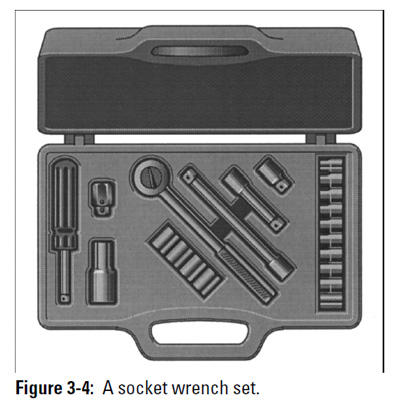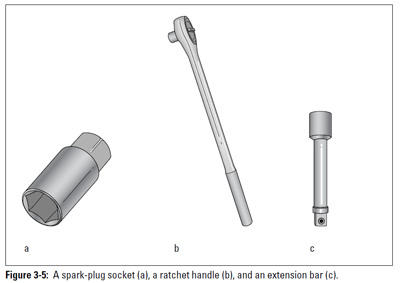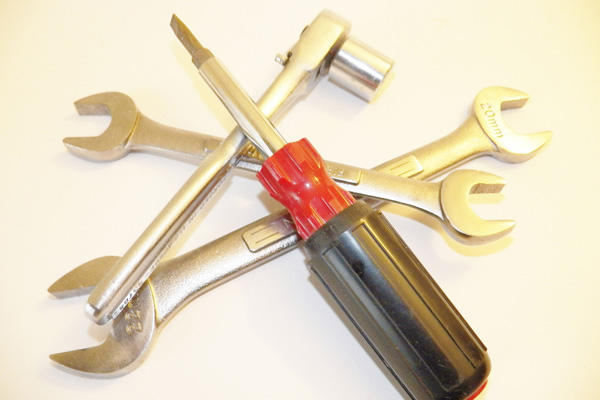Wrenches
Wrenches are probably the most basic tools for auto repair. You need a couple of different kinds in different sizes. There are several types of wrenches, and some have very specialized uses, but the following sections cover the kinds you need for most jobs. Look for sets made by well-known toolmakers, and try to buy them on sale. (For more pointers on buying tools, see the earlier section "Shopping for Tools.")
Most wrenches are available in both standard — also known as SAE (Society of Automotive Engineers) — and metric measurements. Before you go wrenchshopping, know which system of measurement your vehicle is based on. Originally, most foreign vehicles were based on the metric system (except British ones, which had their own thread standard), whereas domestic engines used SAE standards based on fractions of an inch. Today, most American vehicles have a mix of SAE and metric nuts and bolts. Foreign vehicles or foreign components used on American vehicles (a practice that's becoming quite common) use metric nuts and bolts — even the inch-based British. Check your owner's manual or ask your dealer to tell you whether your vehicle requires metric or standard SAE tools before you buy anything.

Socket wrenches
A good set of socket wrenches, shown in Figure 3-4, can really make the difference between enjoying your work and killing yourself over it. Socket wrenches come in sets for a wide variety of prices, depending on quality and how many wrenches are in the set. Sets can include a mix of SAE and metric sockets, all SAE sockets, or all metric pieces. Unless you've decided to become a mechanic, you can buy an inexpensive set of basic socket wrenches suitable for your vehicle and home repairs. If you're not sure you're up for anything major, start with just a sparkplug socket, a ratchet handle, and an extension bar that lets you easily reach the socket deeper into the engine compartment, as required for some spark plug changes (see Figure 3-5).

A good set of socket wrenches should contain the following basic items:
- A variety of 1⁄4-inch, 3⁄8-inch, or 1⁄2-inch drive sockets.
- A spark-plug socket: This large socket has a soft lining to hold the spark plug securely without damaging its soft jacket when you remove and insert it. Spark plugs come in two sizes, so be sure to get the size that fits the spark plugs in your vehicle. Your owner's manual may note the spark plug size, or you can ask your dealership or service shop. The word "drive" refers to the size of the square hole in each socket where it attaches to the ratchet handle. It's easy to remember that the smaller the drive, the smaller the job you use it for. You can use adapters to convert sockets of one drive to fit handles of another drive.
- At least one ratchet handle, which allows you to turn the socket as many times as you need to without having to remove the handle from the socket after each turn: The ratchet handle should fit any of the sockets. Most sets have two or three handles with at least one adapter. You may want to add additional extensions to extend the handle to different sizes and adapt it to different drives.
- A flex-head handle: Although not strictly necessary, a flex-head handle is very useful because it enables you to hold the ratchet handle at any angle when working in tight places — and engines are full of tight places!
- Socket extenders: These indispensable items help you get your socket head way down into the bowels of your engine compartment to reach those almost-unreachable nuts and bolts.
The way to identify a good socket wrench set is by the number of teeth in the ratchet handle. Most have 20 to 30 teeth. The really good ones have up to 60 teeth. The more teeth the handle has, the better it can fit into tight places. With more teeth, you have to move the handle only a few degrees to turn the nut as much as a cheaper handle would in many degrees. In other words, a ratchet handle with 24 teeth must be moved 15 degrees to reach its limit, but a handle with 60 teeth has to be moved only 6 degrees to turn a nut as far.F
Combination wrenches
When shopping for wrenches, you'll come across open-end wrenches and boxend wrenches, but the very best kind to get are combination wrenches, which have both an open end and a boxed end (see Figure 3-6). These wrenches come in sets of several sizes, and each wrench is made to fit a nut of a specific size, whichever end you use. See the sidebar "Using a combination wrench like a pro" for details.

|
Using a combination wrench like a pro Here are a few tips for using a combination wrench:
|










